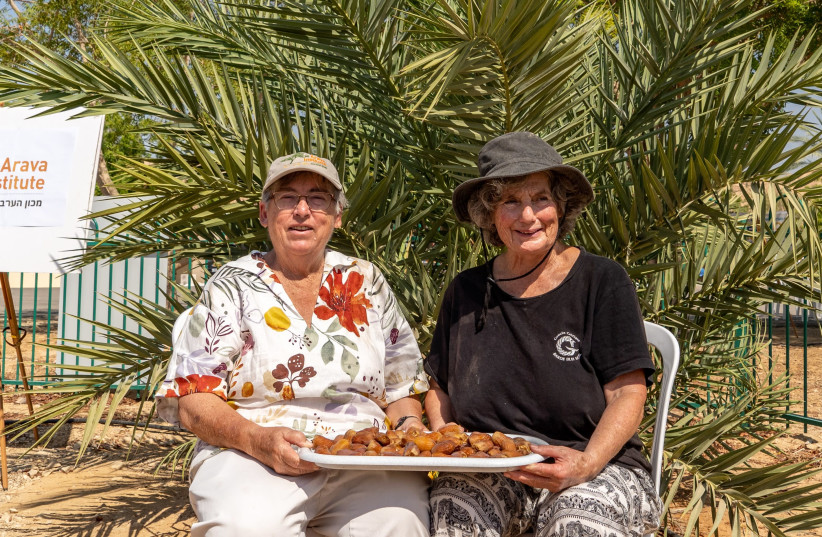For a number of years, I have written before Tu Bishvat about a date palm tree in the Arava that fascinated me. Masada is about two hours from Kibbutz Ketura, but its connections are a lot closer.
London-born Dr. Sarah Sallon, director of the Louis Borick Natural Medicine Research Center at the Hadassah Medical Center, Ein Kerem, has been friends with California-born botanist of the Arava Institute for Environmental Studies at Kibbutz Ketura, Dr. Elaine Solowey, for many years.
“In 2005, we were interested in rejuvenating lost flora of Eretz Yisrael,” said Sallon. “One of the lost flora is the Judaean date. I was discussing with some scientists about their work, trying to extract DNA from ancient seeds.” Sallon asked them: “If we had ancient seeds, why couldn’t we grow them?”
Masada came up in the conversation. The fortress, built by King Herod between 37 and 31 BCE, was home to almost a thousand zealots until the Romans breached the wall in 72 CE and found the bodies of the Jews. From 1963 to 1965, archaeologists Yigal Yadin and Ehud Netzer excavated Masada and found date palm seeds at the approach to the Northern palace. They became part of the custodianship of Netzer, stored at Bar-Ilan University.
Sallon had the idea to plant the seeds and see if they would grow. Hadassah asked her what the seeds had to do with them and she replied: “We study natural therapies.” Hadassah agreed to let Sallon become involved on three conditions: “Don’t ask us for money, don’t ask us for anything, and don’t embarrass us!”

Sallon directs a research center that studies complementary alternative and integrated medicine through the Middle Eastern Medicinal Plant Project.
After looking at the medicine of Tibet, as an introduction to the ancient world of traditional medicine, they began to look at the medicinal plants of Eretz Yisrael, of which there are approximately 2,900 species. Sallon asked Prof. Netzer if they could have a few seeds, and they were given five palm seeds. She took them to her colleague, Dr. Solowey.
Solowey took three of the 2,000-year-old seeds and planted them in January 2005. Other seeds were sent to the University of Zurich for radio-carbon dating and medicinal testing. The date palm was one of the best medicinal trees, domesticated over 6,000 years ago. It can be male or female, and the babies are dates. The medicine of the date palm was used for lung disease, colds, heart disease, hair growth and other things.
After eight weeks, one seed successfully germinated in March of 2005 and was named Methuselah, the biblical character who was said to have lived 969 years.
Initially, the first leaves had white spots because of a lack of chlorophyll. At 15 months, the seedling was transferred to a larger pot. After 26 months, the plant showed normal development.
Sallon says it is in the Guinness Book of Records as the oldest cultivated seed. In 2011, I was permitted to see a still photograph of Methuselah on the computer when its exact location was being kept a secret. At that time, it was two meters high and in a “protected quarantine site,” due to its scientific and financial value.
In April 2011, a white flower appeared on the inner part of the tree, indicating that Methuselah was, indeed, male.
In 2017, there was hope for Methuselah, a male tree, to be bred with a female to produce the same date variety commonly eaten in ancient Judea, where it was valued as much for its delicious flavor as for its medicinal properties.
“I’m trying to figure out how to plant an ancient date grove,” said Solowey. If she could reach her magical green thumb back in time and succeed in bringing forth a modern grove of ancient trees, it might provide for a unique insight into history.
“We would know what kind of dates they ate in those days and what they were like,” said Solowey. “That would be very exciting.”
In December 2019, Solowey sent me an update on Methuselah with a photo. “I attach a picture of Methuselah. He is a big boy now – Methuselah is four meters tall.”
During the year, Solowey reproduced six ancient date seeds from archaeological sites: “Adam” from Masada; “Jonah,” “Uriel,” “Boaz” and “Judith” from Qumram; and “Hannah” from Wadi Makukh. (Wadi Makukh is a winter water channel in the Judean Desert surrounded by high cliffs and containing a number of caves that were surveyed from 1986 to 1989. She was part of a group of seven seeds selected for this study.)
Also in December, Solowey wrote that Methuselah had pollinated a modern female – Hannah. She now had 111 semi-dry dates, “really nice big blondish semi-dry dates from her with a honey aftertaste.” Hannah is 175 years older than Methuselah.
In March 2020, Hannah flowered. “We are still waiting for our second female to flower,” Solowey wrote. “We are thinking of making a genetic line from Hannah.”
A month and a half ago, Solowey wrote: “Well, we got 600 beautiful dates from Hannah whose seed was 175 years older than Methuselah’s seed this September. We planted Yehudit, another female, on Succot. We are considering tissue culture. I have two males still in the greenhouse.”
Methuselah remains in his permanent home in the Arava Institute research park on Kibbutz Ketura. ■
The writer is a Jerusalem-based journalist, lecturer, book reviewer and food writer.
